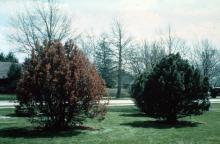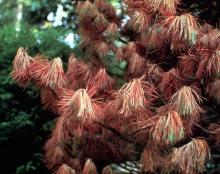Cause This disease involves complicated interactions between a pathogenic nematode (Bursaphelenchus xylophilus, the pine wood nematode), its vector beetle, host pine species, and fungi in the dead tree. Pathogenicity of the pine wood nematode is determined not only by its physical and chemical traits but also by its behavioral traits. The pine wood nematode is known to infest many species of Pinus, with Austrian pine (P. nigra), Scotch pine (P. sylvestris), and Japanese black pine (P. thunbergii) the most susceptible in the eastern United States. Ponderosa pine (P. ponderosa), lodgepole pine (P. contorta var. murrauyana), and white pine (P. albicaulis) are not as susceptible.
The nematode was found in central Oregon on 8 of 105 samples of green ponderosa pine lumber but was not found in statewide Douglas-fir, redwood or white fir samples. Because of its potential, several European countries (Finland, Norway, and Sweden) and Korea have established embargoes against the importation of coniferous wood from regions of the world known to be infested with the pine wood nematode. Although the pine wood nematode is not considered an economic pest in North American forests, the recent embargoes have established an impact on current forest management practices and an economic impact on North American export trade.
The mechanism causing quick death of large pine trees, due to the tiny nematodes, is thought to be a dysfunction of the water conducting system caused by the death of parenchyma cells.
Symptoms Sudden death of trees occurs during heat stress where trees exhibit needle chlorosis, wilting and browning.
Cultural control Exported lumber is kiln-dried which kills both nematode and beetle vectors.
References Bergdahl, D.R. 1988. Impact of pinewood nematode on North America: Present and future. Journal of Nematology 20:260-265.
Dwinell, L.D. 1993. Incidence of the pine wood nematode in green coniferous sawn wood in Oregon and California. Research note SE 367. US Dept. of Agriculture, Forest Service, Southeastern Forest Experiment Station.




